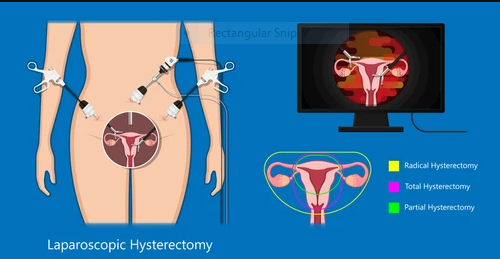Total Laparoscopic Hysterectomy (TLH)
Overview -
The uterus (womb) and cervix are removed using a small surgical telescope called a laparoscope during a total laparoscopic hysterectomy (TLH). The laparoscope is placed through a tiny incision into the abdominal wall and allows the clinician to inspect the pelvis and abdomen. Without a big abdominal incision, the uterus and cervix are removed. The ovaries and tubes are not need to be removed during a hysterectomy; but, if medically necessary, they can be removed at the same time.
Why it's done -
The uterus (womb) and cervix are removed using a tiny surgical telescope called a laparoscope during a complete laparoscopic hysterectomy (TLH). The laparoscope is inserted through a small incision into the abdominal wall, allowing the clinician to examine the pelvis and abdomen. Without a big abdominal incision, the uterus and cervix are removed. The ovaries and tubes do not have to be removed during a hysterectomy, although they might be if medically required.
For more information related to TLH Surgery, Please visit Medipulse hospital or Gynecology & Obstetrics & Urogynecology departments of Our hospital to get an expert opinion on your problem
Surgery Procedure –
Depending on the size of your uterus, the doctor will make a tiny incision at your belly button to pass the laparoscope through, then 2-4 more incisions in your lower abdomen to implant critical surgical equipment after you've been sedated with general anaesthesia. To expand, carbon dioxide gas will be needed. the abdomen in order for the doctor to insert the laparoscope and visualise the abdomen/pelvis. The laparoscope will be used to separate the uterus from the ligaments and blood arteries that surround it. At the top of the head, an incision will be created. vagina to release the uterus and cervix; the incision will then be closed with dissolvable sutures, and necessary blood vessels will be cauterised to avoid bleeding. After that, the uterus is removed via the vaginal canal. A Morcellator will be used to divide the uterus into small pieces, which will subsequently be removed from the body through one of the incisions. The procedure is completed by suturing the top of the vagina, the appropriate layers of the abdomen, and the skin, as well as putting dressings to the incision sites.
Risk and complications -
Unexpected complications can occur during every surgical procedure, regardless of its complexity or duration. They can appear right away or take a long time to appear. While we covered these and perhaps more concerns at your consultation, we'd like you to have a list of particular complications so you may ask questions if you're still concerned. A list of probable risks, aside from anaesthetic difficulties, would include, but is not limited to:
Organ Injury
Infection
Vascular Injury
Blood Loss/Transfusion
Cancer Spread
Painful Intercourse and Vaginal Shortening
Hematoma
Chronic Pain
Numbness
Cuff Dehiscence
Permanent Injury/Death
Insurance Covered – Following insurances are covered for TLH :
| Health Insurance | Insurance covered |
|---|---|
| Chiranjeevi swasthya bima yojana / Ayushman bharat yojana | ✗ |
| RGHS | √ |
| ECH | √ |
| Indian Railway | √ |
| CGHS | √ |
| ESIC | √ |
| RBSK | ✗ |
| Ayushman CAPF | √ |
The average length of stay - entails 4 days in hospital & 4-6 weeks to fully recover.
FAQ-
1.What is the difference between TLH and LAVH?
Gynecologists perform LAVH, because they have already undergone training for vaginal hysterectomy, and TLH requires technical expertise and a longer learning period,7 which could have affected the result of this study
2.Are you hollow after a hysterectomy?
Keep in mind, that in most cases, the uterus is about the size of a small pear. But, a uterus with large fibroids can be extremely large- as large as a nine month pregnancy. The reality is, no matter the size of the uterus that is removed, there is no "empty space" following removal.
3. Why is my stomach bigger after hysterectomy?
Internal lower abdominal and pelvic swelling can take a number of months to subside after a hysterectomy. Abdominal hysterectomy and abdominal incisions can cause the deep abdominal muscles to stop working. When these muscles stop working, this can make your belly look floppy and larger in size
4. Do TLH surgery surgeons in Medipulse Hospital, Jodhpur provide guidance to manage post-operative pain?
In Medipulse Hospital, doctor will recommend appropriate medicines or pain management options for post-operative care.
5. Does health insurance cover TLH surgery at Medipulse Hospital, Jodhpur?
Yes, In Medipulse Hospital, Jodhpur health insurance cover Total Laparoscopic Hysterectomy (TLH) surgery. It is recommended to inquire with the insurance provider at Medipulse Hospital for more details.
Doctors who perform TLH Surgery procedure :
Dr. Mili Inania
Department of Gynecology & Obstetrics & Urogynecology
Area of expertise
Urogynecology, Cosmetic Gynecology, TLH 500+, NDVH 500+, SUI tape 20+, Laparoscopy & Hysteroscopy procedures 1000+, Thermiva Laser 30 +, Trained in urogynecology and pelvic reconstruction surgery (Ohio, USA)


